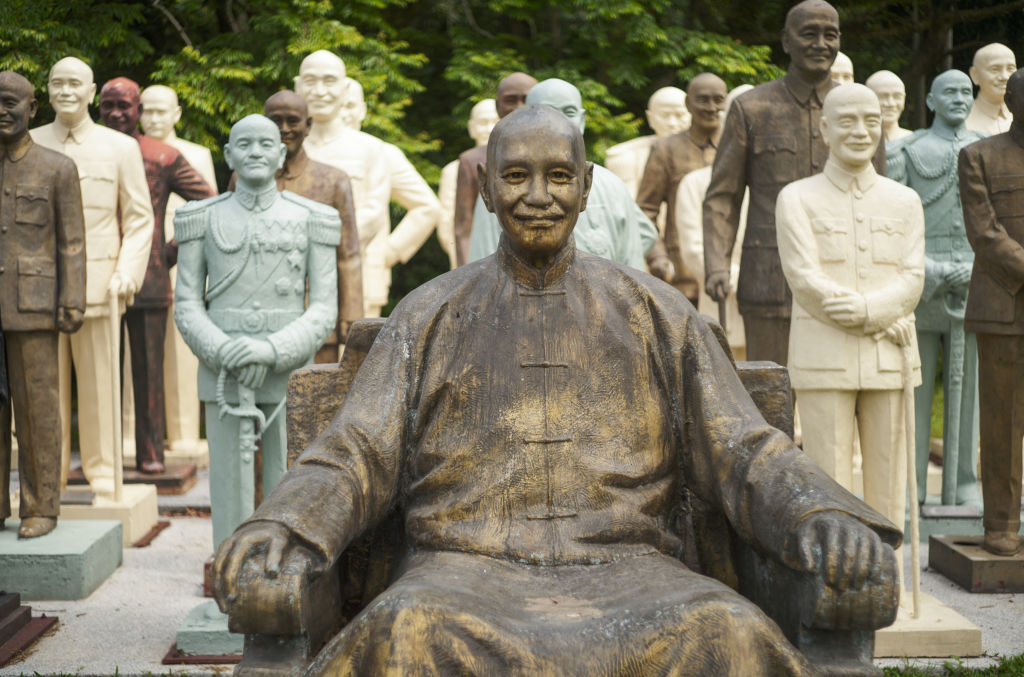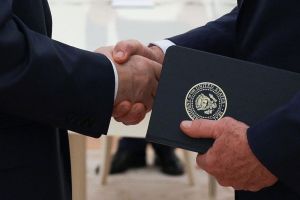While the West obsesses about whether or not China’s supreme leader, Xi Jinping, is going to invade Taiwan, the Taiwanese seemingly have other concerns. Today the hot issue is statues. To be precise, statues of Chiang Kai-shek, the post-war founder-dictator of independent modern Taiwan.
In an inventory taken in 2000 it was estimated that there were over 43,000 statues of Chiang in Taiwan. A removal process, albeit limited in scale, begun shortly after. Some 150 statues were removed and taken to the sculpture garden that surrounds the mausoleums of Chiang and his son Chiang Ching-kuo — a place often referred to as the “Garden of the Generalissimos.” So why then is the newly elected Taiwanese Democratic Progressive party President, Lai Ching-te, planning to remove 760 more Chiang statues?
To explain why the statue issue is such a hot topic with not insignificant relevance to Taiwan’s current and future relationship with China, we need to delve back a little in history to the Chinese civil war that brought Mao Zedong to power. By 1947 the parts of China controlled by Chiang were falling into chaos. While a Japanese military arsenal had fallen into the hands of Mao’s communist forces after the Pacific war, Chiang was relatively starved of equipment by a US State Department which tended to believe the Zhou Enlai propaganda that Mao was more of a rebel against the corrupt government of the Chiang’s Kuomintang (Nationalists) than a hardline communist.
The resulting collapse of morale within the Kuomintang forces combined with Mao’s seizure of the countryside destroyed the economies of China’s cities where Chiang was strongest. Food shortages and the printing of money to finance military expenditure brought hyperinflation and civil unrest. In Shanghai between 1946 and 1947 there were 4,200 labor strikes. Panic spread as Mao’s armies advanced.
As defeat loomed, Chiang developed a plan B, which was to fall back on the island of Taiwan (formerly Formosa). The island had been liberated from Japan in 1945 after fifty years of Japanese rule following their victory in the First Sino-Japanese War. At the peace Treaty of Shimonoseki, Taiwan was ceded to Japan. When Chiang sent an advance guard of 48,000 troops to Taiwan in 1946, they were welcomed as liberators.
Although the islanders and the Kuomintang were both ethnically Han, there was an almost immediate mismatch of expectations on both sides. An article in the Kuomintang magazine New Taiwan Monthly in September 1946 noted the need to re-educate the Taiwanese because they had been “poisoned intellectually and were forced to accept twisted notions.” To a large extent the Han Chinese on Taiwan had been Japanized. Chiang Kai-shek’s regime thus sought to make Taiwan more Chinese. Even so, when I first went to Taiwan in the 1980s the educated older generation still spoke Japanese.
Rather than making it a province, Chiang appointed his protégé Chen-Yi as governor general and garrison commander. Chen-Yi’s poorly paid soldiers plundered and looted — and not just from the departing Japanese. Rigged auctions took place to sell off Japanese property or that of “collaborators.” Owners of desirable properties were sometimes falsely accused. Most of this ended up in the hands of mainlanders. Some 40,000 Japanese bureaucrats were replaced by Kuomintang administrators who imposed an even more draconian control of the economy. They granted themselves state monopolies in salt, opium alcohol and tobacco.
It was this last monopoly which led to the uprising against the Kuomintang invaders as they had become to be seen. In 1947, on February 28, an elderly grandmother, Lin Chiang-mai, was pistol whipped by a Monopoly Bureau agent for illegally selling cigarettes on the street. An angry crowd gathered, and a bystander was shot dead. What followed was an uprising and the Kuomintang’s brutal suppression which became known as “the White Terror.” Some 3,000 to 4,000 were executed, up to 30,000 died in the uprising and five times more were incarcerated. Martial law lasted until 1987.
Not surprisingly the indigenous Han Taiwanese developed a hatred for the mainland Chinese — it is a hatred that has passed down the generations. When I mentioned the 228 Incident to a young Taiwanese hedge-fund manager a few years ago, she launched into colorful invective against the mainlanders. While they are forced to exist together because of their shared antipathy towards communism, strong sentiment remains. The relationship was summed up by an islander who commented, “The Red Pigs are worse than the white ones (Kuomintang) — we hate them all but if we can’t get independence, we’d rather have the present ones.”
Because of the White Terror it is no surprise then that the issue of Chiang Kai-shek’s statues remains sensitive. After all, passions run high when it comes to statues of much older nineteenth-century figures, such as the Confederacy monuments in the United States and Britain’s statues of slave traders such as that of Bristol’s Edward Colston.
In Taiwan today Chinese mainlanders and their descendants are still called Waishengren (mainlanders) and would tend to support the Kuomintang Chinese Nationalist Party. Meanwhile Han Chinese inhabitants and their descendants of Taiwan pre-1945 are called Benshengren (islanders). These people are generally supporters of the Democratic Progressive Party (DPP), which was only founded in 1986 as dictatorial martial law was coming to an end. Both groups of course are Han immigrants, albeit of different generations. (Sixteen of Taiwan’s original aboriginal tribes are officially recognized and live in the island’s densely forested hills and mountains.)
Paradoxically, given the People’s Republic of China’s long civil war with the Kuomintang for control of the mainland, Xi Jinping may not look on the removal of Chiang Kai-shek’s statues favorably. The DPP would like independence from China. They may hedge around the wording, but they reject the long-held mantra that Taiwan is part of China’s “two systems, one country” fudge that was hammered out in the Nixon-Mao agreements of the early 1970s. As James Yifan Chen, professor of international relations at Tamkang University, Taipei, has pointed out, President Lai is pushing for the removal of Chiang’s statues by White Terror Memorial Day on May 19. It will likely be seen by Beijing as a further attempt to de-Sinicize Taiwan.
This is a concern to Beijing because opinion polls clearly show that Taiwanese people are rapidly moving away from the idea that they are Chinese. In 1991, 25.5 percent of Taiwanese identified as Chinese, while 17.6 percent identified as Taiwanese. By 2020 the proportion who identified as Taiwanese more than doubled to 64.3 percent. Those who identified principally as Chinese have fallen to a minuscule 2.6 percent. Meanwhile identification as both Chinese and Taiwanese has fallen by 41 percent.
Another factor in the Chiang statue debate is the position of Taipei’s new mayor, forty-six-year-old Chiang Wan-an — popularly known as Wayne Chiang. He is the illegitimate great-grandson of Chiang Kai-shek. Given that three former mayors of Taipei have gone on to become president, the DPP rightly fear that Wayne Chiang could go on to challenge for the presidency next time round for the Kuomintang. The DPP and President Lai therefore have every reason to want to remind the electorate of the White Terror instigated by Wayne Chiang’s infamous great-grandfather.
But ultimately domestic political issues that resonate in Taiwan nearly always lead back to big brother across the water: China and its current leader Xi Jinping.
This article was originally published on The Spectator’s UK website.


























Leave a Reply